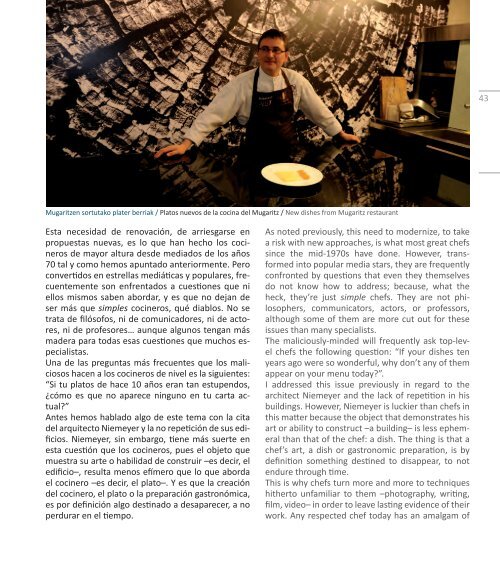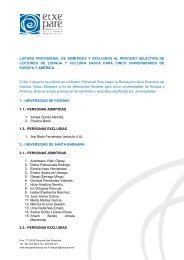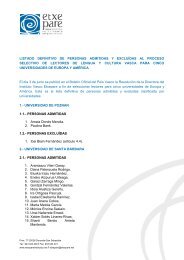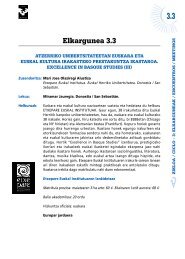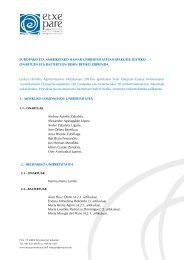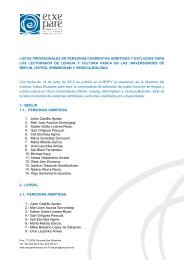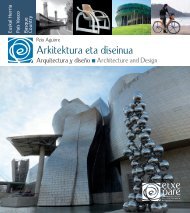Euskal sukaldaritzaz - Etxepare, Euskal Institutua
Euskal sukaldaritzaz - Etxepare, Euskal Institutua
Euskal sukaldaritzaz - Etxepare, Euskal Institutua
Create successful ePaper yourself
Turn your PDF publications into a flip-book with our unique Google optimized e-Paper software.
Mugaritzen sortutako plater berriak / Platos nuevos de la cocina del Mugaritz / New dishes from Mugaritz restaurant<br />
Esta necesidad de renovación, de arriesgarse en<br />
propuestas nuevas, es lo que han hecho los cocineros<br />
de mayor altura desde mediados de los años<br />
70 tal y como hemos apuntado anteriormente. Pero<br />
convertidos en estrellas mediáticas y populares, frecuentemente<br />
son enfrentados a cuestiones que ni<br />
ellos mismos saben abordar, y es que no dejan de<br />
ser más que simples cocineros, qué diablos. No se<br />
trata de filósofos, ni de comunicadores, ni de actores,<br />
ni de profesores… aunque algunos tengan más<br />
madera para todas esas cuestiones que muchos especialistas.<br />
Una de las preguntas más frecuentes que los maliciosos<br />
hacen a los cocineros de nivel es la siguientes:<br />
“Si tu platos de hace 10 años eran tan estupendos,<br />
¿cómo es que no aparece ninguno en tu carta actual?”<br />
Antes hemos hablado algo de este tema con la cita<br />
del arquitecto Niemeyer y la no repetición de sus edificios.<br />
Niemeyer, sin embargo, tiene más suerte en<br />
esta cuestión que los cocineros, pues el objeto que<br />
muestra su arte o habilidad de construir –es decir, el<br />
edificio–, resulta menos efímero que lo que aborda<br />
el cocinero –es decir, el plato–. Y es que la creación<br />
del cocinero, el plato o la preparación gastronómica,<br />
es por definición algo destinado a desaparecer, a no<br />
perdurar en el tiempo.<br />
As noted previously, this need to modernize, to take<br />
a risk with new approaches, is what most great chefs<br />
since the mid-1970s have done. However, transformed<br />
into popular media stars, they are frequently<br />
confronted by questions that even they themselves<br />
do not know how to address; because, what the<br />
heck, they’re just simple chefs. They are not philosophers,<br />
communicators, actors, or professors,<br />
although some of them are more cut out for these<br />
issues than many specialists.<br />
The maliciously-minded will frequently ask top-level<br />
chefs the following question: “If your dishes ten<br />
years ago were so wonderful, why don’t any of them<br />
appear on your menu today?”.<br />
I addressed this issue previously in regard to the<br />
architect Niemeyer and the lack of repetition in his<br />
buildings. However, Niemeyer is luckier than chefs in<br />
this matter because the object that demonstrates his<br />
art or ability to construct –a building– is less ephemeral<br />
than that of the chef: a dish. The thing is that a<br />
chef’s art, a dish or gastronomic preparation, is by<br />
definition something destined to disappear, to not<br />
endure through time.<br />
This is why chefs turn more and more to techniques<br />
hitherto unfamiliar to them –photography, writing,<br />
film, video– in order to leave lasting evidence of their<br />
work. Any respected chef today has an amalgam of<br />
43


